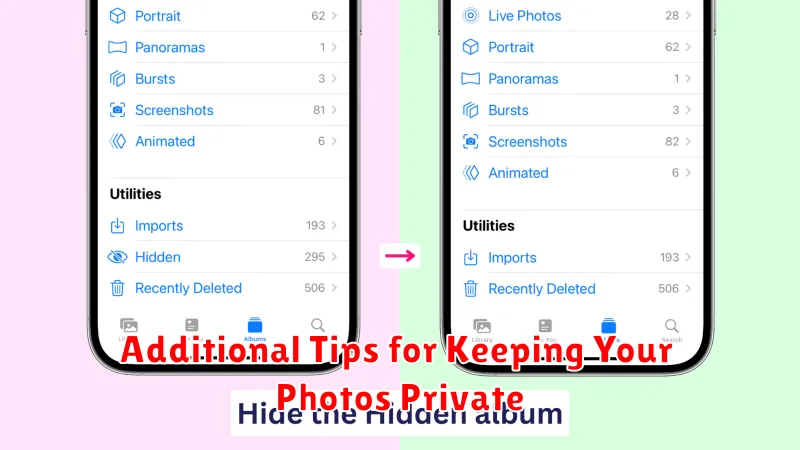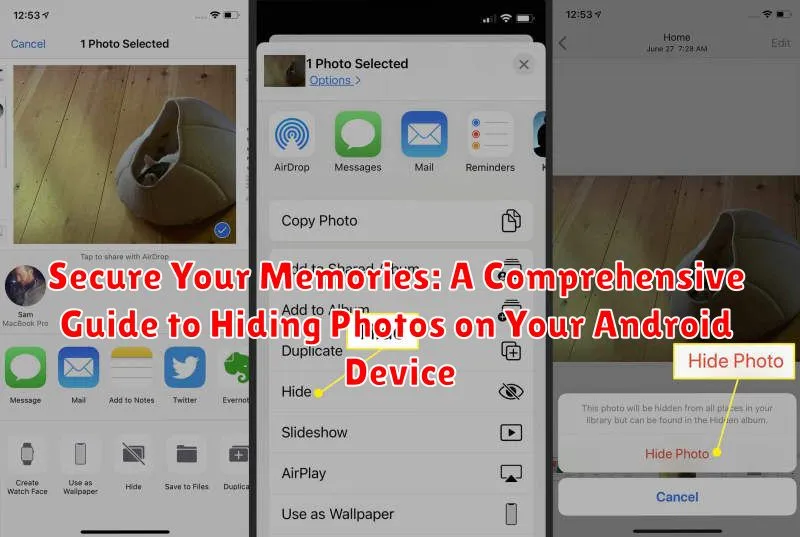In today’s digital age, our Android devices hold a treasure trove of personal memories, captured in countless photos. Protecting these private images is paramount. This comprehensive guide explores the various methods for hiding photos on your Android device, ensuring your sensitive memories remain secure and confidential. We’ll delve into built-in features, third-party apps, and advanced techniques, offering a solution for every user, regardless of technical expertise. Whether you’re concerned about casual snooping or require robust security measures, this guide will equip you with the knowledge to safeguard your cherished moments.
From simple photo hiding options within your gallery to employing encrypted vaults and utilizing private file management systems, we’ll cover a spectrum of approaches to secure your photos. Learn how to hide photos on your Android device effectively and choose the method that best suits your needs. We’ll examine the pros and cons of each technique, helping you make an informed decision to protect your digital privacy and keep your private memories safe from prying eyes. This guide offers the essential information to keep your photos hidden, offering peace of mind in a world where digital security is increasingly crucial.
Understanding the Importance of Photo Privacy
In today’s digital age, our smartphones have become repositories of our personal lives, holding countless photos capturing cherished memories and sensitive information. Protecting these photos is paramount to maintaining our privacy and security.
Consider the potential consequences if your device is lost or stolen. Without adequate protection, your personal photos could fall into the wrong hands, leading to potential misuse, embarrassment, or even identity theft. Privacy isn’t just about keeping secrets; it’s about controlling access to your personal information and safeguarding your digital well-being.
Beyond physical security, digital security is equally crucial. Sharing devices with family or friends necessitates a level of privacy to protect sensitive photos from unintended viewing. Protecting your photo privacy allows you to share your device freely without compromising your personal information.
Built-in Android Features for Hiding Photos
Many Android devices offer basic photo hiding functionalities directly within their gallery apps. These features can provide a quick and easy way to shield selected photos from casual viewing. However, the level of security may be limited compared to other methods.
Archive Feature: Many Android gallery apps include an “Archive” feature. Archiving photos typically removes them from the main gallery view but keeps them accessible within a separate archived album. This is convenient for decluttering your gallery while retaining easy access to the archived images. However, it’s important to note that the archive feature may not be truly private, as someone with access to your device could still locate the archived album.
Secure Folder (Samsung Devices): Samsung devices often include a “Secure Folder” feature. This folder offers a more secure space to store sensitive data, including photos. Files moved to the Secure Folder are encrypted and require authentication to access. This offers significantly better protection than simple archiving.
Device Specific Options: Different Android manufacturers and custom ROMs may offer additional built-in features for photo privacy. Refer to your device’s user manual or online documentation for specific instructions and options.
Using Third-Party Apps for Enhanced Security
While built-in features offer basic protection, third-party apps often provide enhanced security measures for hiding photos on your Android device. These apps typically employ stronger encryption methods and offer a wider range of privacy-focused features.
Numerous apps are available on the Google Play Store designed specifically for photo and video privacy. When choosing an app, consider features such as military-grade encryption, secure vault options, and break-in alerts. Some apps also offer features like disguising their icon to further enhance secrecy.
Research and compare different apps to find one that best suits your security needs. Pay attention to user reviews and ratings to ensure the app’s reliability and effectiveness.
Remember to carefully review the app’s permissions before installation to understand what data it accesses and how it’s used. Opt for reputable apps from established developers to minimize security risks.
Protecting Your Hidden Photos with a Password or PIN
Adding an extra layer of security to your hidden photos is crucial. While hiding photos removes them from the main gallery, a password or PIN prevents unauthorized access should someone discover your hiding method.
Many third-party apps designed for hiding photos offer built-in password or PIN protection. Enabling this feature is highly recommended. This adds a significant security barrier, ensuring only those with the correct credentials can view your private images.
Some Android devices also provide secure folders or vaults that can be locked with a password, PIN, or biometric authentication. Moving your hidden photos into these secure locations offers robust protection. Even if your device is unlocked, the contents of the secure folder remain inaccessible without the proper authentication.
Choose a strong password or PIN that is difficult to guess. Avoid easily discernible combinations like birthdays or simple number sequences. Consider using a password manager to generate and store strong, unique passwords for your various accounts, including those protecting your hidden photos.
Moving Photos to a Secure Folder or Vault
Many Android devices offer a built-in secure folder or vault feature. This provides a dedicated, encrypted space to store sensitive files, including photos. Moving photos to this secure area removes them from the main gallery app and requires authentication to access them.
The specific steps to move photos to a secure folder might vary slightly depending on your device’s manufacturer and Android version. Generally, the process involves selecting the desired photos in your gallery app, looking for an option like “Move to Secure Folder” or “Move to Vault,” and then following the on-screen prompts. You will likely need to set up the secure folder or vault initially if you haven’t already, usually involving choosing a strong password or PIN.
This method adds an extra layer of security as the photos are not only hidden but also encrypted. Even if someone gains access to your device, they won’t be able to view the photos without the correct credentials.
Additional Tips for Keeping Your Photos Private

While hiding photos is a crucial step, consider these additional precautions for enhanced privacy.
Be Mindful of App Permissions: Review the permissions granted to your apps. Avoid granting access to your photos to apps that don’t require it. Revoke permissions from suspicious apps immediately.
Regularly Update Your OS and Apps: Security updates often include patches for vulnerabilities that could compromise your privacy. Keeping your software updated is a simple yet effective security measure.
Screen Lock is Essential: Always use a strong screen lock, such as a PIN, password, or biometric authentication. This prevents unauthorized access to your device and all its contents, including hidden photos.
Beware of Cloud Backups: If you utilize cloud backups, understand which folders are included. Hidden folders might still be backed up. Configure your backup settings to exclude sensitive data.
Disable Lock Screen Notifications: Prevent previews of incoming messages or notifications from appearing on your lock screen. This adds an extra layer of privacy, especially if you receive messages containing photos you prefer to keep private.
Restoring Hidden Photos When Needed

Retrieving your hidden photos is a straightforward process, varying slightly depending on the method used to hide them. If you utilized your device’s built-in file manager or gallery app, simply reverse the steps you took to hide them. This often involves unselecting the “hide” option or removing the files from a designated “.nomedia” folder.
For third-party apps, the restoration process depends on the specific application. Consult the app’s instructions, but generally, you’ll locate an “unhide” or “restore” function within the app’s interface. This may require your password or PIN for security verification.
If you moved your photos to a secure folder or vault, access the folder or vault using your credentials. From there, select the photos you wish to restore and choose the “move” or “extract” option. Specify the destination folder where you want the photos to reappear in your regular gallery.
Remember, restoring photos removes the protection afforded by hiding them. Ensure you choose a safe location on your device for the restored files, or consider backing them up to a secure cloud storage service for added peace of mind.

